大館ばやしのお囃子- Odate Bayashi
大館ばやしの歴史History of Odate Bayashi
大館ばやしは古くから大館神明社例祭の際に余興奉納されていた祭りばやしで、「寄せ囃子」「大館祇園囃子」「剣囃子」「還り山」の四曲が伝承されています。
Odate Bayashi is a festival dance that has been dedicated to the entertainment of the Odate Shinmei Shrine Festival since ancient times, and four songs have been handed down from generation to generation: Yose-bayashi, Odate Gion-bayashi, Ken-bayashi, and Kaeri-yama.
初期の頃は四町(大町、馬喰町、中町、新町)の分限者(資産家)から奉納された分限山車と呼ばれる飾り山車の後を囃子方がはやしを演奏しながら付き従っており、囃子山と呼ばれました。明治時代の末頃に街中に電線が張り巡らされると、それまで高さを競っっていた鉾や飾り山車は運行できなくなり、店舗や宅地に置山として姿を変え、神明社のご神幸行列には囃子山だけが参加するようになりました。それまで分限山と一対となっていた囃子山はその機動性を生かし、いろいろな場所へ単独で運行されるようになりました。最初は人が担いでいましたが、手踊りを披露するようになり、さらには芸子が加わるようになり、曳き山へと変わっていきました。これが現在の山車の原形となっています。
In the early days of the festival, the floats were called “Bungen floats" because they were dedicated by wealthy people in four towns (Omachi, Bakuromachi, Nakamachi, and Shinmachi). In the late Meiji era (1868-1912), when electric lines were built around the city, the floats and decorative floats that had competed in height were no longer allowed to operate, and were replaced by floats placed in stores and residential areas. Only the music float began to participate in the Shinmeisha shrine procession.In the past, these were paired with the "bungen-yama", but with their mobility, the "hayashi-yama" came to be operated independently to various places. In the beginning, they were carried by people. At first, the floats were carried by people, but then they began to be accompanied by hand dances, and then by geishas, and became hiki-yama. This is the original form of today's floats.
大館囃子で使われる楽器Instruments used in Odate musical performance
01大太鼓large or bass drum
長胴(ながどう)太鼓(宮太鼓)を使用します。演奏開始、曲目変更、終了は全て大太鼓奏者の掛け声が合図となります。また山車の運行中は周囲の状況を判断しながら曲目を変更するなど、的確な判断力が求められます。
The Nagado taiko (miya-daiko) will be used. The start, change, and end of the performance are all signaled by the call of the taiko player. While the floats are in operation, it is necessary to be able to make accurate judgments, for example, to change the music while assessing the surrounding situation.
02小太鼓small drum
締太鼓を使用します。練習ではバチさばきや腕の位置の統一、全員の叩く音がひとつに聞こえることを目指します。小太鼓奏者はもう一つの楽器「声」も担当します。大きな声が出ていると曳き子にも伝わり、山車全体が活気づきます。
We will be using shimedaiko. In practice, we try to make sure that the bachi (wasp) movements and arm positions are consistent, and that everyone's striking sounds are heard as one. The small taiko player is also in charge of the other instrument, the voice. When the voice is loud, it is transmitted to the floats, and the entire float becomes more lively.
小太鼓は「寄せ囃子」と「還り山」は単調な奏法の繰り返しなので、リズムさえ狂わなければさほど難しくはありません。太鼓はたたけば(上手い下手はありますが)音は出ます。ただ、初心者の子供たちと話していると「途中でどこを叩いているのか分からなくなる」とか「チャッチャをどこでやるのか分からない」と言ってきます。その度「メロディーを覚えること」と言っていますが、今回掲載する楽譜が少しでもお役に立てば幸いです。
As for the small drums, "Yose-bayashi" and “Kaeri-yama" are monotonous repetitions, so they are not very difficult to play as long as the rhythm does not go wrong. As long as you don't get the rhythm wrong, it's not too difficult. If you play the taiko, you can make a sound (whether you are good or not). However, when I talk to children who are beginners, they say, "I lose track of where I'm tapping in the middle of the song," or "I don't know where to play the cha-cha. I always tell them that they need to learn the melody, and I hope that this sheet of music will be of some help.
03篠笛Japanese transverse bamboo flute
篠笛と呼ばれる竹製の横笛を使用します。穴の数や長さによって多くの種類がありますが、大館囃子では「七穴・四本調子」のものを使います。右利きの人は上の三個の穴を左手、下の四個を右手で押さえます。初めはなかなか音が出ず、やっと音が出ても息が続かず苦労します。腹式呼吸を覚えましょう。
A bamboo flute called shinobue is used. There are many types, depending on the number of holes and length, but the Odate musical style uses a "seven-hole, fourth tone" flute. Right-handed people hold the top three holes with their left hand and the bottom four with their right hand. At first, it is difficult to make a sound, and when you finally do, it is hard to keep breathing. Learn to breathe through your abdomen.
また、篠笛は、祭りの練習が始まる頃になると毎年のように「笛を習いたいので教えてください」と入門者がやって来ます。吹奏楽部でフルート経験者なら教えるのも楽なのですが、たいていは全くの初心者です。吹いてもなかなか音が出ず、やっと音が出ても今度は息が続かず酸欠状態に陥ります。息が続くようになったら1オクターブ低かったりと、一人前になるにはかなりの練習が必要です。さらに、「祇園囃子」と「剣囃子」はメロディーを覚えなければ絶対上達しません。筆者も一通りこれらを経験してきました。普段聞いていると思われる「POPS」とは正反対の位置にある民俗芸能の楽器「篠笛」なので、間近で見るのも触るのも初めてという人が殆どであるというのが現状です。
As for the shinobue (bamboo flute), every year around the time the festival practices start, people come to us asking to learn how to play the flute. It's easy to teach them if they have experience playing the flute in a brass band, but most of them are complete beginners. Even if they play the flute, it's hard to get a sound, and even if they finally get a sound, they can't hold their breath and run out of oxygen. It takes a lot of practice to become a full-fledged musician. In addition, you will never be able to play "Gion-bayashi" and "Ken-bayashi" without learning the melody. The author has experienced these in one way or another. The shinobue is a folkloric instrument that is on the opposite side of the spectrum from the "pops" that you usually hear, so most people have never seen or touched one up close before.
04三味線Shamisen
笛や太鼓の音にかき消されないよう大きな音の出る太棹(ふとざお 津軽三味線など)を使用します。昭和初期、芸子が山車に乗るようになってから加わったと考えられていましたが、明治末期の小野呉服店の置山の写真に三味線を持った囃子方が確認できるため(祭典のしおり35号「大館囃子の今昔」写真参照)、もっと古い時代から加わっていたと考えられます。
To avoid being drowned out by the sound of the flutes and drums, a futozao (Tsugaru shamisen) with a loud sound is used. It was thought to have been added in the early Showa period when geishas began to ride on the floats, but a photo of Ono Kofukuten's Okiyama from the end of the Meiji period shows a musician with a shamisen (see "Odate-bayashi Now and Then" photo in Festival bookmark No. 35), so it is thought to have been added from an even older time.
05摺鉦(すりがね)Surigane
記録では大館ばやし保存会が結成された時に加わったとされています。以前は太鼓のメンバーが交代で担当していた講が多かったのですが、最近では初めから「鉦(かね)をやりたい」と志願してくる中高生が多いと聞いています。リズムパートの要です。
According to records, the gong was added when the Odate Bayashi Preservation Association was formed. In the past, many of the taiko drummers took turns playing the gong, but recently I have heard that many junior and senior high school students have volunteered to play the gong from the beginning. The gong is the key to the rhythmic part.
大館ばやしの篠笛を演奏するにはHow to play the Odate Bayashi shinobue flute
まずは、篠笛の難しさFirst, the difficulty of the shinobue flute.
祭りの練習が始まる頃になると毎年のように「笛を習いたいので教えてください」と入門者がやって来ます。吹奏楽部でフルート経験者なら教えるのも楽なのですが、たいていは全くの初心者です。それも普段聞いていると思われる「POPS」とは正反対の位置にある民俗芸能の楽器「篠笛」なので、間近で見るのも触るのも初めてという人が殆どです。
Every year around the time the festival practice starts, a new student comes to the school asking to learn the flute. It's easy to teach them if they have experience playing the flute in a brass band, but most of them are complete beginners. Most of them have never seen or touched a shinobue flute before, as it is a folk instrument that is the opposite of the "pops" that they usually listen to.
太鼓はたたけば(上手い下手はありますが)音は出ます。しかし笛はそうはいきません。吹いてもなかなか音が出ず、やっと音が出ても今度は息が続かず酸欠状態に陥ります。息が続くようになったら1オクターブ低かったりと、一人前になるにはかなりの練習が必要です。筆者も一通りこれらを経験してきました。
If you play the taiko drum, you can make a sound (although you may not be good at it). However, this is not the case with the flute. It's hard to make a sound when you play it, and even when you finally do, you can't hold your breath and run out of oxygen. It takes a lot of practice to become a full-fledged flute player. The author has experienced all of these things.
笛の選び方How to select a flute
篠笛は長さにより一~十二までの調子(キー)に分けられます。また指で押さえる穴(指孔)も六つのもの(写真上)と七つのもの(写真下)があります。さらに、日本古来のお囃子で使う「囃子用」と西洋音階(ドレミファソラシド)に合うように調律した「唄用」にも分けられます。大館囃子では「四本調子、七つ穴、囃子用」の笛を用います。
Shinobue flutes are divided into one to twelve keys depending on their length. There are also two types of finger holes, one with six holes and the other with seven holes. It is also divided into two types: one for the traditional Japanese musical accompaniment and the other for singing, tuned to the Western musical scale (do re mi fa sola do). In the Odate musical style, a flute with four keys, seven holes, and for musical accompaniment is used.
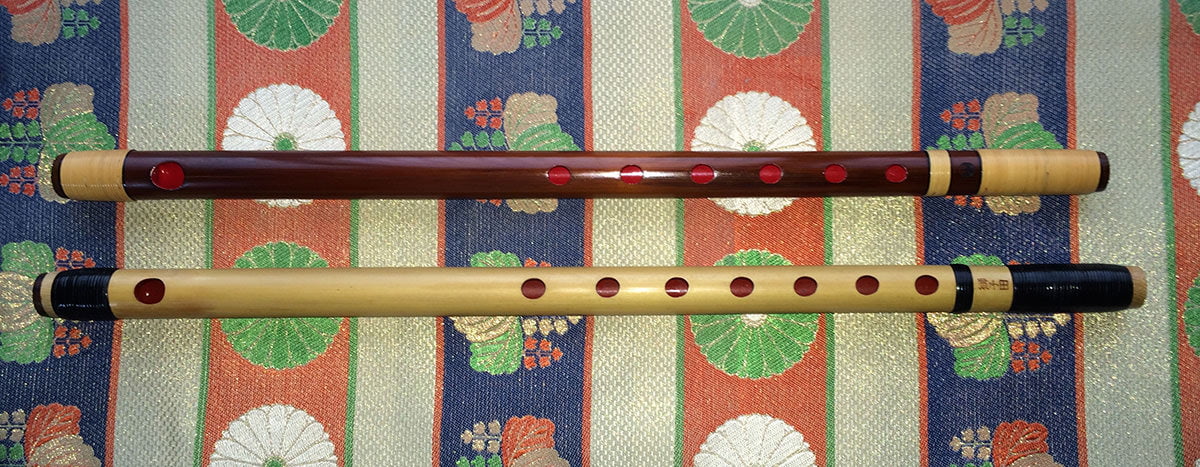
笛の音の出し方How to make a flute sound
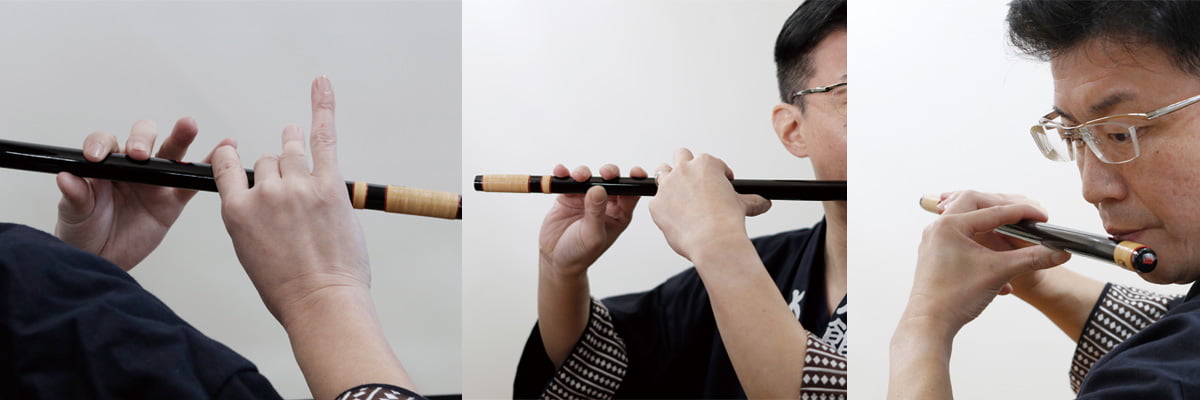
- 1,指穴の押さえ方と指の位置
- 2,歌口と唇の中心を合わせる
- 3,笛と唇の位置
大館ばやしの曲リストList of Odate Bayashi songs
前奏曲Prelude
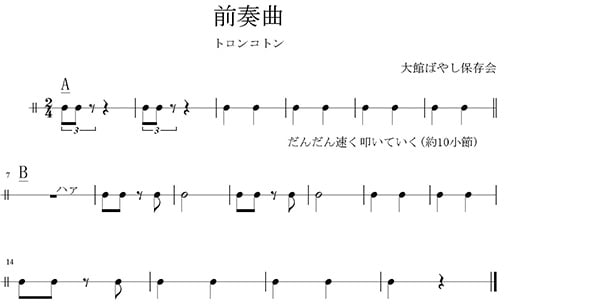
大太鼓の「はー・あっ」と言うかけ声を合図に「トロン・トロン・トロトロトロ…」と演奏が始まります。初めの3小節は普通の速さで、4小節から約10小節はだんだん速くなります。
The performance starts with a "Ha-ah" from the big drum, followed by "Tron, tron, tron, tron, tron, tron...". The first three bars are at a normal speed, and from bar 4 to about bar 10, the speed gradually increases.
また、大太鼓のかけ声で普通の速さに戻り「トロンコトン・トロンコトン…」と続きます。前奏曲としていますが曲と曲との間奏や終奏としても使われます。
It also returns to normal speed with the call of the big drum, and continues with "Tronkoton, tronkoton...". This piece is used as a prelude, but it can also be used as an interlude or a finale between songs.
寄せ囃子Yose bayashi
祭りの始まりを告げるお囃子。曳き子に集合をかける合図にも使われます。
The musical accompaniment that signals the beginning of the floats festival. It is also used as a signal to Hikiko to assemble.
「トロン・トロン・トロトロトロ~」と太鼓の連打の後、「トロコ・ストロコ・トン、トロコ・ストロコ・トン」とバチの反動を利用しての太鼓の奏法に入りますが、かなり難しいため、初心者や小学生には「トン・トン・トン、トン・トン・トン」
After a series of "tron, tron, trotrotro" and drumming, we move on to "tron, tron, troko, stroko, ton, troko, stroko, ton" a drumming technique using the recoil of the bachi, which is quite difficult, so beginners and elementary school students may find it difficult to understand "tron, tron, tron, tron."
大太鼓に関しては基本的な叩き方は指導しています。しかし本来、この曲に限っては奏者が創意工夫して自由に叩いて良いとされています。
We teach the basic way to play the big drum. However, in this piece, the player is allowed to be creative and play freely.
小太鼓を演奏するにはHow to play the small drum
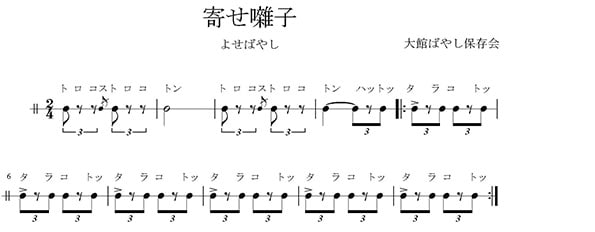
- 前奏曲「A」の後、かけ声に続いて「トロコストロコトン」の演奏が始まります。
- After the prelude "A," the “Troko , stroko, ton" begins to play, followed by a shout.
- 「トロコストロコトン」の休符の部分でもバチが微妙な動きをしているのが分かります。各自研究してみてください。
- You can also see the subtle movement of the bachi in the rest part of "Troko , stroko, ton”. Please study it yourself.
- 繰り返しの小節の1拍目はアクセント記号です。強く叩きメリハリを付けてください。
- The first beat of the repeated measure is an accent mark. Please hit it hard and make it crisp.
大太鼓を演奏するにはHow to play the wide drum
こちらは、大館ばやし保存会の2代目会長 越前屋清氏の寄せ囃子 大太鼓演奏の記録映像です。
Here is a video recording of Yosebayashi O-daiko performance by Kiyoshi Echizenya, the second president of Odatebayashi Preservation Society.
大館祇園囃子Odate Gion-Bayashi
大館囃子を代表する曲で、「大館祭り囃子」ともいわれており、京の祇園囃子の流れをくむと言われ、ゆったりと優雅に演奏されます。五つのテーマに分けられ、一つのテーマを二回ずつ繰り返して演奏されます。
This is a representative piece of Odate music, also known as "Odate Matsuri-bayashi", which is said to be based on the Gion-bayashi of Kyoto, and is played in a relaxed and elegant manner. It is divided into five themes, and each theme is repeated twice.
「弥栄(いやさか)サッサー・ヨーイヨイ」と、掛け声が入り、運行の際に最も数多く演奏されます。
It is most often played during the operation, with the call “yiyasaka Sasser Yoi Yoi.
最近ではめったに聞かれなくなりましたが、芸子が山車に乗っていた時代には歌詞を付け、小唄風に唄われていました。
It is rarely heard these days, but in the days when geishas rode on floats, lyrics were added and the song was sung in a kouta style.
小太鼓を演奏するにはHow to play the small drum
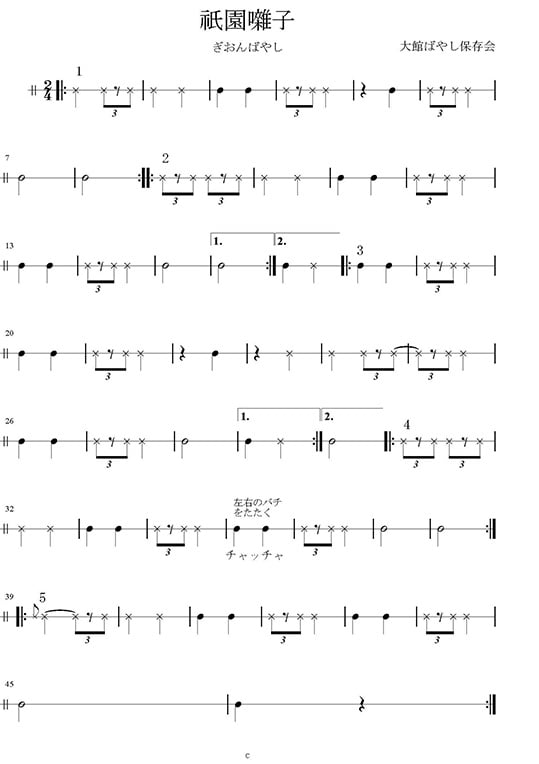
- 1から5までのテーマから成っており、各テーマを2回ずつ繰り返して演奏していきます。
- It consists of themes from 1 to 5, and each theme is repeated twice.
- 楽譜の「×」は太鼓の縁を叩きます。
- The “x" in the score strikes the edge of the drum.
- 4番の「チャッチャ」の部分(35小節目)は左右のバチを拍子木のように打ち合います。その後で太鼓の縁と皮面を逆に叩くことがあるので注意します。
- In the "chatcha" part of the fourth (bar 35), the left and right bachi are struck together like clappers. Be careful, as you may then hit the edge of the drum and the skin surface in opposite directions.
- 3番は12小節と長く(他のテーマは8小節)それまでとは違った叩き方があるので注意します。
- Note that No. 3 is 12 bars long (the other themes are 8 bars long) and has a different strumming style than the previous ones.
剣囃子Ken-bayashi
その昔、侍がこの曲に合わせて「剣の舞」を舞ったと言い伝えられております。
It is said that in the past, samurai danced the "sword dance" to this song.
三つのテーマからなっており、笛は「あや」と呼ばれる装飾音を駆使して演奏します。山車運行中にも演奏されますが、各講・各町内の祭典事務所前で停止し、踊りを披露する場合に演奏することが多いようです。
It consists of three themes, and the flute is played with a decorative sound called "aya". The flute is played while the floats are in operation, but it is often stopped in front of the festival office of each school and township to perform the dance.
剣囃子(拳囃子)と呼ばれるものは各地に存在しており、花輪囃子の拳囃子や角館・飾山(おやま)囃子の拳囃子は似かよったメロディーが所々に出てきます。また千葉県・佐原(さわら)囃子の拳囃子も似ているらしいとウェブサイトに載せたところ、大館の剣囃子をアレンジしたとの連絡がありました。
Ken-bayashi (fist music) exists in many places, and the fist music of Hanawa-bayashi and the fist music of Kakunodate and Oyama-bayashi have similar melodies in some places.When I posted on my website that the ken-bayashi of Sawara-bayashi in Chiba Prefecture is also similar, I was informed that it is an arrangement of Odate's ken-bayashi.
八戸大学では「祭り囃子への印象評定に地域特異性はみられるか」という研究テーマで剣囃子が地元の「八戸えんぶり」やバロック音楽との比較対象で使われています。ただこの論文では剣囃子が大館囃子の中心となる曲として使用されており、ここでは是非祇園囃子の方を使ってほしかったと思います。
At Hachinohe University, Ken-bayashi is used in the research theme "Is there regional specificity in the evaluation of impressions of festival music? However, in this paper, Ken-bayashi is used as the central piece of Odate music, and I would have preferred that Gion-bayashi be used here.
小太鼓を演奏するにはHow to play the small drum
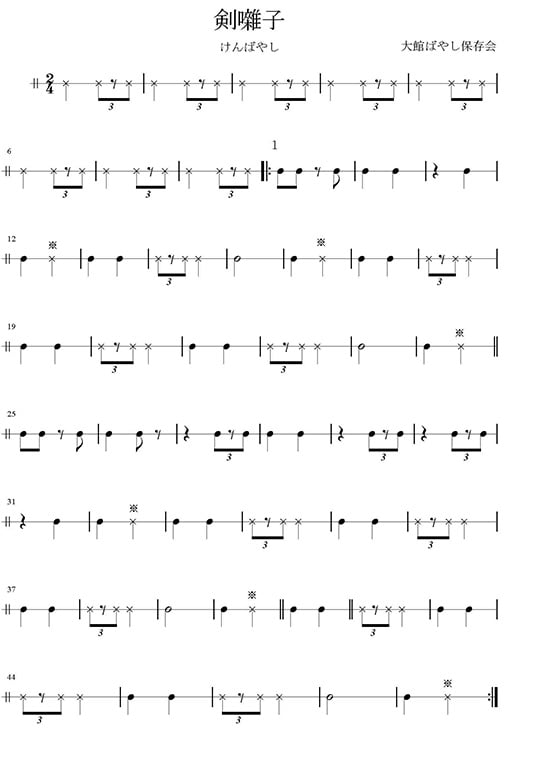
- 楽譜の「×」は太鼓の縁を叩き、上に「※」がある所は両手で縁を叩きます。
- The “x" in the score is to tap the edge of the drum, and where there is a "*" above, tap the edge with both hands.
- 最後まで演奏したら反復記号のある9小節目へ戻ります
- When you've reached the end, go back to bar 9 with the repetition mark.
- この曲も太鼓の縁を叩きます。縁の中には鉄の輪が入っていますので、強く叩くとバチが折れたり、ささくれたりします。縁を叩くときにはやさしく叩きましょう。
- This song also involves hitting the rim of the drum. There is an iron ring in the rim, so if you hit it too hard, the bachi will break or get chipped. When striking the rim, be gentle.
還り山Kaeri-yama
戦場から勇ましく勝ち鬨(かちどき)を揚げて帰る凱旋の曲と伝えられております。
It is said to be a song of triumphant return from the battlefield with a battle cry of victory.
八つのテーマからなっており、一つのテーマを二回ずつ繰り返して演奏されます。ワンコーラス演奏した後は三から八までのテーマを繰り返し演奏します。
It consists of eight themes, each of which is played twice. After one chorus, themes three through eight are played repeatedly.
初めはゆっくりとしたテンポで入り、次第に速くなっていきます。「ワッショイ・ワッショイ」と掛け声が入り、山車同士がすれ違う際、登り坂に差し掛かった際、自町内へ戻る際に演奏されます。また、曳き子が疲れてきたときにはカンフル剤的な役割を果たします。
The tempo is slow at first and then gets faster. It is played when the floats pass each other, when they approach an uphill slope, and when they return to their own neighborhoods. It also plays a role of camphor when the floats get tired.
小太鼓を演奏するにはHow to play the small drum
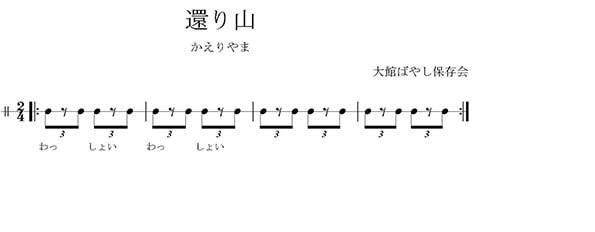
- 前奏曲の一番最後「四分休符」の代わりに太鼓の縁を「チャッ」と叩いて「還り山」の演奏に入ります。
- Instead of a "quarter rest" at the end of the prelude, the edge of the drum is beaten with a "cha-ching" to start the performance of Kaeri-yama.
- 小太鼓奏者は声も楽器の一部です。「わっしょい・わっしょい」と大きなかけ声を出しましょう。
- As a taiko player, your voice is part of your instrument. Let's make a loud "wasshoi, wasshoi" sound.
楽譜をまとめてダウンロードする
大館ばやしの太鼓楽譜をダウンロードする
その他others
秋田音頭や、オリジナル囃子などAkita Ondo, original music, etc.
昭和30年代までは、囃子方が仲間内だけで演奏した「鳥音頭(とりおんど)」と称する曲があったと伝えられています。しかし残念ながらテープなどの音源は残っておりません。
It is said that until the 1950s, there was a song called "Tori ondo," which was performed by the musicians only among their friends. Unfortunately, there are no tapes or other sound sources left.
山車見世、駅前囃子共演では大館囃子用に編曲された「秋田音頭」を披露する講もあります。またオリジナルの囃子を持つ講も増えてきており、各イベントで披露されています。
There are also some groups that perform "Akita Ondo" arranged for Odate music at the float viewing and in front of the Odate station. There are also an increasing number of groups with their own original music, which is performed at various events.
市内各地に伝わっていた獅子踊り、獅子舞等の民俗芸能が後継者不足から存続が危ぶまれたり、歌詞は残っていても歌を歌える人がいなくなってしまったとの話を聞くにつれ、絶えることなく大館ばやしを残していただいた先人の皆様に感謝いたします。また保存会の発展のためご助言と数多くの演奏機会をお作りいただいき、平成29年6月24日ご逝去された大館神明社前名誉宮司・佐藤文彦様に感謝いたします。
The survival of folk performing arts such as lion dances and lion dances, which have been handed down in various parts of the city, is in danger due to a lack of successors, and although the lyrics have been preserved, there is no one who can sing the songs anymore. I would also like to express my gratitude to Mr. Fumihiko Sato, former honorary priest of Odate Shinmeisha, who passed away on June 24, 2017, for his advice and many opportunities to perform for the development of the preservation society.
【参考資料 祭典のしおり第二号・第九号、祭りと大豊講、祭り囃子への印象評定に地域特異性はみられるか(畑山、金地・八戸大学)】
In addition to the above, it is important to note that there is no specificity in the evaluation of the impressions of the festival music (Hatayama and Kanechi, Hachinohe University).
大館ばやし保存会の課題などIssues of Odate Bayayashi Preservation Association, etc.
大館囃子では小太鼓の初めの一振り(一拍目)を左手から叩くと決めています。このことはバチの持ち方、構え方などと一緒に練習の初めに初心者に教えてきました。私も何の疑問も持ちませんでしたがある時、曲げわっぱ太鼓の安保さんから「左から叩くのはおかしいのでは…」との指摘を受けました。気になって越前屋元会長に左手から叩く理由を聞いたところ「深い意味はない。ただ決めただけ」との答えでした。
In Odate music, it is decided that the first swing (first beat) of the small drum should be played from the left hand. This has always been taught to beginners at the beginning of practice, along with how to hold the bachi and hold the stance. I didn't have any doubts about it, but one day, Mr. Anbo of Bend-Wappa Taiko pointed out to me that it was strange to start from the left. I was curious, so I asked Mr. Echizenya, the former chairman, why he beat the drum from the left hand. I just decided to do it.
ドラムの経験者に聞いても利き手でリズムを取るので、普通は右手が一拍目となる、とのことでした。YouTubeでいろいろな囃子を見てみましたが、殆ど右手から入っていました。
I asked an experienced drummer about it, and he said that the right hand is usually the first beat because the dominant hand takes the rhythm.
「祇園囃子」と「剣囃子」はメロディーと同じリズムで叩くので、メロディーさえ覚えれば左手からでも難しくありません。「寄せ囃子」では一拍目を休符と考えれば左手から打つのも理にかなっています。「還り山」は「タッタ、タッタ、タッタ…」の繰り返しで、洋楽の「シャッフル」呼ばれるリズムと同じです。左手から叩いて途中からテンポが速くなると、どうしてもリズムが狂いがちになります。講によっては右手からに統一している所もあるようです。日本人の約9割の人は右利きとのことなので、今後検討すべき課題と思っています。
Gion-bayashi and Ken-bayashi are played with the same rhythm as the melody, so it's not difficult to start with the left hand once you learn the melody.In "Yose-bayashi," the first beat is a rest, so it makes sense to play from the left hand. In "Kaeri-yama," the rhythm is a repetition of "ta-ta, ta-ta, ta-ta..." This is the same as the "shuffle" rhythm in Western music. If you start with the left hand and the tempo speeds up in the middle, the rhythm tends to get out of sync. In some schools, the right hand is used first. Since about 90% of Japanese people are right-handed, I think this is an issue that should be considered in the future.
笛の問題点は指の使い方(運指)です。同じ師匠に習っても、その習った時期によって微妙に差があります。それに「あや」と呼ばれる装飾音が入ってきます。あやというのは、例えば西洋音階の「ド・ミ・ソ」の音を出す場合、ミとソの間にファとミをさり気なく入れ「ド・ミ(ファミ)・ソ」と音を出します。 このファとミの音をあやと称しています。このあやも奏者によって入れたり入れなかったり、入れる回数が異なったりしています。
The problem with the flute is the use of the fingers (fingering). Even if you learn from the same teacher, there are subtle differences depending on when you learned.In addition, there are ornamental notes called "aya".For example, in the Western musical scale, when you make the sound "do, mi, so," you casually insert a fa and mi between the mi and so to make the sound "do, mi (fami), so. The sound of the fa and mi is called "aya. Depending on the player, this sound may or may not be added, and the number of times it is added may vary.
保存会の中でさえまちまちだったので、統一するべくシーズンオフに練習会を行っております。また、これだけは使ってほしい最小限のあやを取り入れた模範演奏のDVDを作製し、各講・希望者に配布したいと考えております。
We have been holding practice sessions in the off-season in order to unify the performances, as they have been different even within the Preservation Association. In addition, we would like to make a DVD of a model performance that incorporates the minimum number of phrases that we would like people to use, and distribute it to each class and those who wish to use it.
文責:大館ばやし保存会 石田 誠孝
Written by Seikou Ishida,
Odate Bayayashi Preservation Association.


